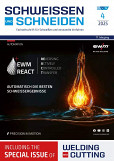Low Temperature Joining of Ni-Based Super- alloys with Ni-Nanoparticles
Autoren: M. Sc. Benjamin Sattler, Dr.-Ing. Susann Hausner, Prof. Dr.-Ing. Guntram Wagner
In this article, investigations about joining with nickel nanoparticles are presented. Compared to the corresponding bulk material, nanoscale particles have a lower melting and sintering temperature. This offers great potential for joining processes at comparatively low temperatures, which can represent an alternative to conventional brazing. Elements, such as boron or silicon, that are used as melting point depressants in common solders and brazes are not needed here. This also prevents the formation of brittle intermetallic compounds in the joint seam. The joining process with nanoparticles is conducted while a pressure is applied on the joining zone with simultaneous heating under vacuum (“nanojoining”), which is similar to diffusion welding processes from a technological point of view. In contrast to this, however, with nanojoining the holding times are significantly shorter (in the range of a few minutes). Further, the nanoparticles or more precisely, the pastes made from them (“nanopastes”) are used as a filler metal in nanojoining. The nanopastes are made from organic compounds and the nickel nanoparticles by ultrasonic-assisted dispersion. Joining tests on nickel superalloys were evaluated with regard to both, the microstructure and the shear strength of the joints.
Als Abonnent haben Sie die Möglichkeit einzelne Artikel oder vollständige Ausgaben als PDF-Datei herunterzuladen. Sollten Sie bereits Abonnent sein, loggen Sie sich bitte ein. Mehr Informationen zum Abonnement













